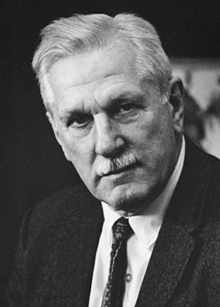Folke K. Skoog
Folke Karl Skoog | |
|---|---|
 | |
| Born | July 15, 1908 Halland, Sweden |
| Died | February 15, 2001 (aged 92) |
| Resting place | Uppsala old cemetery, Sweden |
| Alma mater | Caltech |
| Known for | Murashige and Skoog medium |
| Spouse | Birgit Skoog |
| Awards | National Medal of Science (1991) |
| Scientific career | |
| Fields | Plant physiology |
| Institutions | Caltech, Berkeley, University of Hawaiʻi, Harvard, Johns Hopkins University, Washington University in St. Louis, University of Wisconsin |
| Thesis | Some Physiological Functions of the Growth Hormone in Higher Plants (1936) |
| Notable students | Toshio Murashige |
Folke Karl Skoog (July 15, 1908 – February 15, 2001) was a Swedish-born American plant physiologist who was a pioneer in the field of plant growth regulators, particularly cytokinins. Skoog was a recipient of the National Medal of Science 1991.[1][2]
Born in Halland, Sweden, Skoog emigrated to the United States during a trip to California in 1925, and was naturalized as a citizen almost a decade later. He competed, and finished sixth in heat 2, in the 1500 meter race during the 1932 Summer Olympics.[3] In 1936, he received his PhD in biology from Caltech for his work done with auxin, a plant hormone.
In 1937, Skoog was a postdoctoral researcher with Dennis Robert Hoagland, and his professional career advanced significantly with his arrival at the University of Wisconsin–Madison in 1947. Carlos O. Miller discovered kinetin in 1954,[4] and benzyladenine and related compounds were later synthesized in Skoog's lab.
In 1962, Skoog and Toshio Murashige published what is probably the best-known paper in plant tissue culture; in a fruitless attempt to discover a yet-unknown plant growth regulator in tobacco juice for his doctoral thesis, Murashige and Skoog instead developed a greatly improved salt base for the sterile culture of tobacco. Now referred to as Murashige and Skoog medium, the final paper (Murashige, T. and Skoog, F. (1962) A revised medium for rapid growth and bioassays with tobacco tissue cultures. Physiol Plant 18: 100-127) is one of the most often-cited papers in biology.[5] Now 60 years after the work, M&S salt base remains an essential component in plant tissue culture, but not in hydroponics.[6]
In 1970, Skoog was elected a foreign member of the Royal Swedish Academy of Sciences.
References[edit]
- ^ Peter V. Minorsky (April 2001). "Tribute to Folke Skoog". Plant Physiology.
{{cite journal}}: Cite journal requires|journal=(help) - ^ Folke K. Skoog on National Science Foundation.
- ^ Folke Skoog Archived October 26, 2012, at the Wayback Machine on sports-reference.com
- ^ "Richard M. Amasino | Faculty | Biochemistry | UW-Madison" (PDF). 3 July 2019.
- ^ Richard Van Noorden, Brendan Maher and Regina Nuzzo (29 October 2014). "The top 100 papers". Nature. 514 (7524). Nature News: 550–553. Bibcode:2014Natur.514..550V. doi:10.1038/514550a. PMID 25355343. S2CID 4466906.
- ^ van Delden, S.H.; Nazarideljou, M.J.; Marcelis, L.F.M. (2020). "Nutrient solutions for Arabidopsis thaliana: a study on nutrient solution composition in hydroponics systems". Plant Methods. 16 (72): 1–14. doi:10.1186/s13007-020-00606-4. PMC 7324969. PMID 32612669.
- 1908 births
- 2001 deaths
- Swedish scientists
- California Institute of Technology alumni
- University of Wisconsin–Madison faculty
- National Medal of Science laureates
- Athletes (track and field) at the 1932 Summer Olympics
- Members of the Royal Swedish Academy of Sciences
- Plant physiologists
- Members of the United States National Academy of Sciences
- Olympic athletes for Sweden
- Swedish emigrants to the United States
- Washington University in St. Louis faculty
- Johns Hopkins University faculty
- University of Hawaiʻi at Mānoa faculty
- University of California, Berkeley faculty
- Swedish athletics biography stubs
- European botanist stubs
- Swedish scientist stubs
